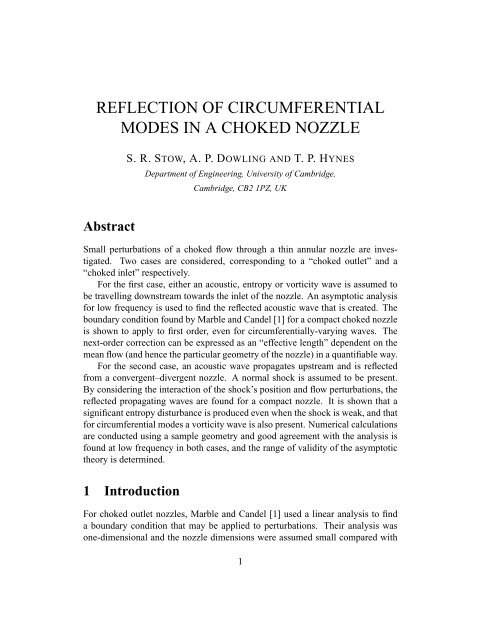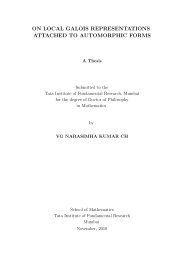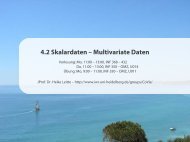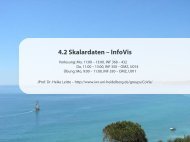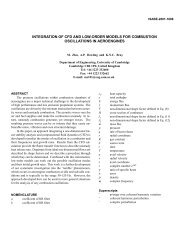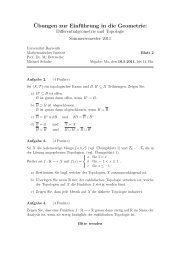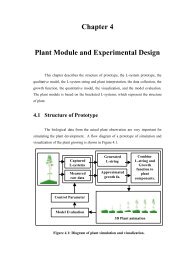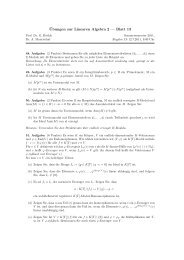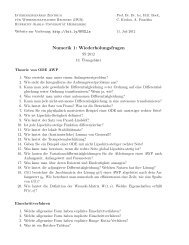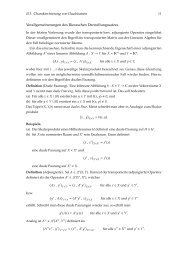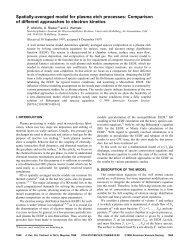reflection of circumferential modes in a choked nozzle - IWR
reflection of circumferential modes in a choked nozzle - IWR
reflection of circumferential modes in a choked nozzle - IWR
Create successful ePaper yourself
Turn your PDF publications into a flip-book with our unique Google optimized e-Paper software.
REFLECTION OF CIRCUMFERENTIAL<br />
MODES IN A CHOKED NOZZLE<br />
S. R. STOW, A. P. DOWLING AND T. P. HYNES<br />
Department <strong>of</strong> Eng<strong>in</strong>eer<strong>in</strong>g, University <strong>of</strong> Cambridge,<br />
Cambridge, CB2 1PZ, UK<br />
Abstract<br />
Small perturbations <strong>of</strong> a <strong>choked</strong> flow through a th<strong>in</strong> annular <strong>nozzle</strong> are <strong>in</strong>vestigated.<br />
Two cases are considered, correspond<strong>in</strong>g to a “<strong>choked</strong> outlet” and a<br />
“<strong>choked</strong> <strong>in</strong>let” respectively.<br />
For the first case, either an acoustic, entropy or vorticity wave is assumed to<br />
be travell<strong>in</strong>g downstream towards the <strong>in</strong>let <strong>of</strong> the <strong>nozzle</strong>. An asymptotic analysis<br />
for low frequency is used to f<strong>in</strong>d the reflected acoustic wave that is created. The<br />
boundary condition found by Marble and Candel [1] for a compact <strong>choked</strong> <strong>nozzle</strong><br />
is shown to apply to first order, even for <strong>circumferential</strong>ly-vary<strong>in</strong>g waves. The<br />
next-order correction can be expressed as an “effective length” dependent on the<br />
mean flow (and hence the particular geometry <strong>of</strong> the <strong>nozzle</strong>) <strong>in</strong> a quantifiable way.<br />
For the second case, an acoustic wave propagates upstream and is reflected<br />
from a convergent–divergent <strong>nozzle</strong>. A normal shock is assumed to be present.<br />
By consider<strong>in</strong>g the <strong>in</strong>teraction <strong>of</strong> the shock’s position and flow perturbations, the<br />
reflected propagat<strong>in</strong>g waves are found for a compact <strong>nozzle</strong>. It is shown that a<br />
significant entropy disturbance is produced even when the shock is weak, and that<br />
for <strong>circumferential</strong> <strong>modes</strong> a vorticity wave is also present. Numerical calculations<br />
are conducted us<strong>in</strong>g a sample geometry and good agreement with the analysis is<br />
found at low frequency <strong>in</strong> both cases, and the range <strong>of</strong> validity <strong>of</strong> the asymptotic<br />
theory is determ<strong>in</strong>ed.<br />
1 Introduction<br />
For <strong>choked</strong> outlet <strong>nozzle</strong>s, Marble and Candel [1] used a l<strong>in</strong>ear analysis to f<strong>in</strong>d<br />
a boundary condition that may be applied to perturbations. Their analysis was<br />
one-dimensional and the <strong>nozzle</strong> dimensions were assumed small compared with<br />
1
the shortest wavelength <strong>of</strong> the perturbed flow. The case <strong>of</strong> three-dimensional disturbances<br />
was <strong>in</strong>vestigated by Crocco and Sirignano [2]. However they assumed<br />
a similarity form which excludes the present th<strong>in</strong> annular geometry. For a compact<br />
<strong>choked</strong> <strong>in</strong>let, attention has <strong>of</strong>ten been restricted the case <strong>of</strong> a weak shock<br />
followed by smooth area <strong>in</strong>crease. It has then been assumed (see for example [3])<br />
that entropy perturbations are negligible lead<strong>in</strong>g to a simple <strong>reflection</strong> coefficient<br />
for plane acoustic waves. However <strong>in</strong> Section 4 we show that this assumption<br />
is <strong>in</strong>correct. The ma<strong>in</strong> purpose <strong>of</strong> this work is to derive the appropriate boundary<br />
conditions for <strong>choked</strong> <strong>in</strong>let and outlet <strong>nozzle</strong>s when <strong>circumferential</strong>ly-vary<strong>in</strong>g<br />
<strong>modes</strong> are present and to test them by comparison between analytical and numerical<br />
results.<br />
Lean premixed prevaporised (LPP) combustion can reduce NO x emissions<br />
from gas turb<strong>in</strong>es, but <strong>of</strong>ten leads to combustion <strong>in</strong>stability. Acoustic waves produce<br />
fluctuations <strong>in</strong> heat release, for <strong>in</strong>stance by perturb<strong>in</strong>g the fuel–air ratio or<br />
flame shape. These heat fluctuations will <strong>in</strong> turn generate more acoustic waves<br />
and <strong>in</strong> some situations self-susta<strong>in</strong>ed oscillations can result. It is therefore important<br />
to be able to predict resonant <strong>modes</strong>. To do this it is necessary to known<br />
the boundary conditions that apply at the <strong>in</strong>let and outlet <strong>of</strong> the combustor. For<br />
short annular combustors, typical <strong>of</strong> aeroeng<strong>in</strong>es, <strong>circumferential</strong> <strong>modes</strong> must be<br />
considered but radial dependence is not important. The aim <strong>of</strong> this paper is to f<strong>in</strong>d<br />
the boundary conditions that apply to flow perturbations at a <strong>choked</strong> <strong>in</strong>let and a<br />
<strong>choked</strong> outlet for a th<strong>in</strong> annular geometry.<br />
In Section 2 we show that a l<strong>in</strong>ear disturbance <strong>in</strong> a straight annular duct can<br />
be thought <strong>of</strong> as a sum <strong>of</strong> acoustic, entropy and vorticity waves, with acoustic<br />
waves propagat<strong>in</strong>g both upstream and downstream, while entropy and vorticity<br />
disturbances convect with the mean flow. The equations presented there are required<br />
<strong>in</strong> form<strong>in</strong>g the boundary conditions at the <strong>in</strong>let and outlet <strong>of</strong> the <strong>nozzle</strong> <strong>in</strong><br />
the subsequent sections.<br />
Section 3 conta<strong>in</strong>s an asymptotic analysis <strong>of</strong> a <strong>choked</strong> outlet <strong>nozzle</strong> for low<br />
frequency. To first order the boundary condition for l<strong>in</strong>ear perturbations is found<br />
to agree with the Marble and Candel [1] form for one-dimensional waves. Extend<strong>in</strong>g<br />
the boundary condition to second-order <strong>in</strong> compactness ratio (the product <strong>of</strong><br />
wavenumber and <strong>nozzle</strong> length) the solution is found to depend on the mean flow.<br />
These boundary conditions are used to f<strong>in</strong>d the acoustic wave reflected when a<br />
downstream propagat<strong>in</strong>g acoustic or a convected entropy or vorticity wave is <strong>in</strong>cident<br />
on the <strong>nozzle</strong>. The results are expressed <strong>in</strong> the form <strong>of</strong> a <strong>reflection</strong> coefficient<br />
and an “effective length” for the <strong>nozzle</strong> <strong>in</strong> terms <strong>of</strong> the mean flow.<br />
In Section 4 we consider a compact convergent–divergent <strong>choked</strong> <strong>in</strong>let <strong>nozzle</strong><br />
with a normal shock <strong>in</strong> the divergent section. Now the <strong>in</strong>terest is the determ<strong>in</strong><strong>in</strong>g<br />
the downstream travell<strong>in</strong>g acoustic, vorticity and entropy waves produced by an<br />
<strong>in</strong>cident upstream propagat<strong>in</strong>g acoustic wave. We show that the boundary condi-<br />
2
k§<br />
¯ρα§<br />
tion <strong>of</strong>ten used for a weak shock followed by smooth area <strong>in</strong>crease is <strong>in</strong>correct.<br />
We f<strong>in</strong>d new boundary conditions, that apply even without these assumptions, by<br />
consider<strong>in</strong>g the <strong>in</strong>teraction <strong>of</strong> the shock position and the perturbed flow.<br />
In Section 5 we present numerical results for a particular <strong>choked</strong> <strong>nozzle</strong>. Here<br />
the mean flow is assumed axisymmetric with no <strong>circumferential</strong> velocity and is<br />
calculated numerically us<strong>in</strong>g an Euler code. A l<strong>in</strong>earised Euler technique is then<br />
used to calculate small perturbations to this flow. Firstly, the reflected acoustic<br />
wave is found when a downstream travell<strong>in</strong>g acoustic, entropy or vorticity wave<br />
is <strong>in</strong>cident on a <strong>choked</strong> exit <strong>nozzle</strong>. Secondly, the downstream travell<strong>in</strong>g acoustic<br />
wave produced by an upstream propagat<strong>in</strong>g acoustic wave <strong>in</strong>cident on a <strong>choked</strong><br />
<strong>in</strong>let <strong>nozzle</strong> is calculated. Good agreement is found between the numerical and<br />
analytical results.<br />
2 Analysis for a straight annular duct<br />
We first consider the form <strong>of</strong> perturbations that can occur <strong>in</strong> the gap between two<br />
concentric cyl<strong>in</strong>ders. Us<strong>in</strong>g cyl<strong>in</strong>drical polar coord<strong>in</strong>ates x, r and θ, we are <strong>in</strong>terested<br />
<strong>in</strong> a straight annular duct <strong>of</strong> the form b r a 0. The flow through this<br />
duct is assumed to be <strong>in</strong>viscid, with pressure p, density ρ and velocity ¡ u¢ v¢ w£ .<br />
This flow is taken to be composed <strong>of</strong> a steady axial mean flow (denoted by bars)<br />
and a small perturbation (denoted by dashes). These disturbances are assumed<br />
to have complex frequency ω (i.e. the temporal dependence is <strong>of</strong> the form e iωt ).<br />
We will restrict attention to real ω (although extension to complex ω is straightforward)<br />
and we may take ω to be positive without loss <strong>of</strong> generality. Also, the<br />
angular dependence <strong>of</strong> the perturbations is taken to be <strong>of</strong> the form e <strong>in</strong>θ (where n<br />
is a non-negative <strong>in</strong>teger).<br />
The perturbed flow can be thought <strong>of</strong> as a sum <strong>of</strong> acoustic waves, entropy<br />
waves and vorticity waves. The acoustic waves have the form (see [4, 5])<br />
A§ iωt¨ ik© p¤¦¥ <strong>in</strong>θ¨ r£¢ ¡ ρ¤ ¡ ¥<br />
r£¢<br />
A§<br />
e x B n (2.1a)<br />
1<br />
¯c 2 B n (2.1b)<br />
A§ e iωt¨ <strong>in</strong>θ¨ ik© x B n ¡ r£¢ (2.1c)<br />
v¤ ¥<br />
i<br />
e x dB n ik© A§<br />
dr (2.1d)<br />
r£¢<br />
¯ρα§<br />
n<br />
¡ iωt¨ e x B <strong>in</strong>θ¨ <strong>in</strong>θ¨ ik© A§ n r£ (2.1e)<br />
iωt¨ ¡<br />
¯ρα§ r<br />
u¤¥<br />
(2.1f)<br />
w¤¦¥<br />
3
Here B n ¡ r£¥<br />
dY n<br />
dr ¡ λ n mb£ J n ¡ λ n mr£<br />
dJ n<br />
dr ¡ λ n mb£ Y n ¡ λ n mr£ , ᧥ ω ūk§ and<br />
¯Mω ω 2 ¯c 2 λ 2 n m¡ 1 ¯M 2 £ 1 2<br />
1 ¯M 2 ¢ (2.2)<br />
¯ck§¥<br />
where ¯M is the mean Mach number (which is assumed to be less than unity) and<br />
λ n ¡ m 1£ 0 is the m th solution <strong>of</strong> dJ n<br />
dr λ dY n<br />
dr λ dJ n<br />
n mb£¥<br />
dr λ dY n<br />
¡ n mb£<br />
dr λ ¡ n ma£<br />
n ma£<br />
required to satisfy the rigid wall boundary condition ¡ on r a ¡ and r ¥ b. When ¥<br />
m¡ ω ¯cλ n 1 ¯M 2 2 1 , represents a downstream propagat<strong>in</strong>g wave A<br />
£ A¨ and<br />
represents an upstream propagat<strong>in</strong>g wave. m¡ For ω ¯cλ n 1 ¯M 2 2 £ 1 the waves<br />
are “cut<strong>of</strong>f”; then represents a downstream A decay<strong>in</strong>g disturbance and A¨ represents<br />
an upstream decay<strong>in</strong>g disturbance. 1<br />
Any variations <strong>in</strong> entropy at the <strong>in</strong>let <strong>of</strong> the duct will be convected with the<br />
mean flow. We can consider such variations to be an entropy wave <strong>of</strong> the form<br />
ρ¤ ¥<br />
1<br />
¯c 2 A E eiωt¨ <strong>in</strong>θ¨ ik 0 x E ¡ r£¢ (2.3)<br />
with p¤ ¥ u¤ ¥ v¤ ¥ w¤ ¥ 0, where k 0<br />
¥ ω ū and E ¡ r£ can be any function <strong>of</strong><br />
r. Vorticity variations are also convected along the duct, and can similarly be<br />
considered as a wave. This can be thought <strong>of</strong> as a sum <strong>of</strong> two types <strong>of</strong> vorticity<br />
wave, one where the radial velocity is zero and one where the <strong>circumferential</strong><br />
velocity is zero. (There are just two degrees <strong>of</strong> freedom <strong>in</strong> the vorticity waves<br />
because <strong>of</strong> the constra<strong>in</strong>t that the divergence <strong>of</strong> the vorticity is zero). The first<br />
type has the form<br />
n<br />
¯ρ ¯c A V ik 0 x V ¡ r£¢<br />
<strong>in</strong>θ¨ eiωt¨<br />
(2.4a)<br />
k 0<br />
r<br />
¯ρ ¯c A V eiωt¨ <strong>in</strong>θ¨ ik 0 x V ¡ r£¢<br />
(2.4b)<br />
u¤!¥<br />
w¤¥"<br />
p¤ ¥ ρ¤ ¥ v¤ ¥ with 0, whereas flow perturbations <strong>in</strong> the second type can be expressed<br />
as<br />
1<br />
¯ρ ¯cr A W ik 0 x dW dr ¡ r£¢<br />
<strong>in</strong>θ¨ eiωt¨<br />
(2.5a)<br />
ik 0<br />
¯ρ ¯cr A W eiωt¨ <strong>in</strong>θ¨ ik 0 x W ¡ r£¢<br />
(2.5b)<br />
u¤!¥<br />
v¤¥"<br />
p¤ ρ¤ w¤ ¡ r£ ¥ ¥ ¥<br />
a£#¥ ¡ b£#¥ ¡<br />
with 0. Here V can be any function, however we must have<br />
W W 0.<br />
1 Note that the square root <strong>in</strong> (2.2) is taken to be a negative imag<strong>in</strong>ary number <strong>in</strong> this case.<br />
4
3 Asymptotic analysis for a <strong>choked</strong> outlet <strong>nozzle</strong><br />
As well as the compact case, Marble and Candel [1] also considered perturbations<br />
to <strong>choked</strong> flow when the wavelengths are comparable with the <strong>nozzle</strong> geometry.<br />
They assumed both the mean flow and the perturbations to be one-dimensional<br />
and approximated the mean velocity by a l<strong>in</strong>ear function. Here we extend their<br />
analysis by allow<strong>in</strong>g the mean velocity to be a general function <strong>of</strong> x and consider<strong>in</strong>g<br />
<strong>circumferential</strong>ly vary<strong>in</strong>g perturbations.<br />
We consider an axisymmetric <strong>nozzle</strong> 0 x x max , r m<strong>in</strong><br />
x£$ r r ¡ max x£ , as ¡<br />
shown schematically <strong>in</strong> figure 1. We suppose that there is a section at the <strong>in</strong>let<br />
where the <strong>nozzle</strong> is simply the gap between two concentric cyl<strong>in</strong>ders as considered<br />
<strong>in</strong> Section 2, i.e. r m<strong>in</strong><br />
x£%¥ a, r ¡ max b. After this the cross-sectional area <strong>of</strong> the<br />
¥<br />
<strong>nozzle</strong> decreases to a throat at ¥ x& x before <strong>in</strong>creas<strong>in</strong>g aga<strong>in</strong> (see Section 5 for a<br />
particular example). The mean flow through the <strong>nozzle</strong> is assumed to be <strong>choked</strong>,<br />
with ¥ ū¡ x£ ū a known function (perhaps taken from steady numerical calculations<br />
as described <strong>in</strong> Section 5) and ¥ ¯v ¥ ¯w 0. Lett<strong>in</strong>g L be a typical axial length-scale<br />
<strong>of</strong> the <strong>nozzle</strong> and writ<strong>in</strong>g ¥ X x L, we take the perturbed flow to be <strong>of</strong> the form<br />
p¤<br />
γ ¯p ¥ ˆp¡ X £ eiωt¨ <strong>in</strong>θ ¢<br />
u¤<br />
ū ¥ û¡ X £ eiωt¨ <strong>in</strong>θ ¢<br />
ρ¤<br />
¯ρ ˆρ X <strong>in</strong>θ £ eiωt¨ ¢ (3.1a)<br />
¡ ¥<br />
w¤<br />
¥ X £ e <strong>in</strong>θ (3.1b)<br />
ŵ¡<br />
¯c <strong>in</strong> iωt¨<br />
(where subscript “<strong>in</strong>” denotes values at the <strong>in</strong>let) v¤ ¥ with 0. We also make ω<br />
non-dimensional by tak<strong>in</strong>g ¥ Ω ¯c& Lω (where “' subscript ” denotes values at the<br />
throat). Radially, we assume h¡ x£(¥ that r max x£ r ¡ m<strong>in</strong><br />
x£ is always small and<br />
¡<br />
hence take ) r ¥<br />
1<br />
R 2<br />
a b£ . We use the narrow annular gap form <strong>of</strong> the Euler<br />
¡<br />
equations <strong>in</strong> which the cont<strong>in</strong>uity equation has the form<br />
∂<br />
∂t ρh£* ¡<br />
For l<strong>in</strong>ear perturbations this leads to<br />
iΩ ˆρ <br />
∂ 1 ∂<br />
ρwh£¥ 0+ (3.2)<br />
¡<br />
∂x R ∂θ ρuh£* ¡<br />
U d ˆρ<br />
dX <br />
U dû<br />
dX iΩ cŵ ¥ 0¢ (3.3)<br />
where Ω c ¥ Ln ¯c <strong>in</strong><br />
,¡ R ¯c&-£ and U ¡ X £#¥ ū¡ x£. ¯c& (hence U ¡ X&/£0¥ 1). The l<strong>in</strong>earised<br />
x-momentum equation gives<br />
iΩû <br />
U dû<br />
dX <br />
dU<br />
dX ¡ 2û <br />
ˆρ£*¡ ¯c2 ¯c 2 & £ U 1 d ˆp<br />
dX <br />
d ˆp<br />
γ ˆp ,¡ L ¯c&-£¥ 0+ ¯ρū (3.4)<br />
dX<br />
5
After substitution from the mean axial-momentum equation, d ¯p dū<br />
dx<br />
¯ρū<br />
dx<br />
, and the<br />
steady-flow relationship, ¯c ¥1<br />
2 ¥<br />
1<br />
2<br />
1£ γ ¯c 2 <br />
1<br />
¡ & 2<br />
1£ γ ū 2 , this simplifies to<br />
¡<br />
iΩû U dû 1<br />
dX 2<br />
1£34¡ γ 1£ γ U 2 1<br />
U d ˆp 2¡ <br />
dX<br />
The l<strong>in</strong>earised θ-momentum equation leads to<br />
<br />
<br />
dU<br />
¡ 2û ˆρ γ ˆp£#¥ 0+ (3.5)<br />
dX<br />
iΩŵ <br />
U dŵ<br />
dX 1<br />
2<br />
iΩ c ¡ ¯c& ¯c <strong>in</strong><br />
£ 2 5¡ γ 1£4¡ γ 1£ U 2 ˆp ¥ 0+ (3.6)<br />
The flow through the <strong>nozzle</strong> is assumed to be adiabatic. Therefore, upstream <strong>of</strong><br />
any shocks, DS Dt ¥ 0 which for l<strong>in</strong>ear disturbances leads to<br />
d ˆp d ˆρ<br />
ˆp ¡<br />
iΩ¡ ˆρ £¥ 0+ U (3.7)<br />
£*<br />
dX dX<br />
A particularly useful comb<strong>in</strong>ation <strong>of</strong> these equations <br />
is obta<strong>in</strong>ed by multiply<strong>in</strong>g<br />
(3.5) by 2U then subtract<strong>in</strong>g 2U 1 times (3.3) and U U 1 times (3.7) to give<br />
<br />
U 2û ˆρ ˆp£ U 1 ¡ ˆp ˆρ 2µŵ£<br />
iΩ ¡ <br />
2U dU<br />
dX 2û ˆρ γ U 2 ˆp£6¡ 1£7¡ 2 dû<br />
dX <br />
¡<br />
d ˆρ<br />
dX <br />
where µ ¥ Ω c Ω.<br />
We now consider an asymptotic expansion for small Ω,<br />
γ d ˆp<br />
dX £¥ 0¢ (3.8)<br />
ˆp ¥ ˆp 0<br />
iΩ ˆp 1<br />
O¡ Ω 2 £¢ ˆρ ¥ ˆρ 0<br />
iΩ ˆρ 1<br />
O¡ Ω 2 £¢ (3.9a)<br />
û ¥ û 0<br />
iΩû 1<br />
O¡ Ω 2 £¢ ŵ ¥ ŵ 0<br />
iΩŵ 1<br />
O¡ Ω 2 £+ (3.9b)<br />
(S<strong>in</strong>ce we will be assum<strong>in</strong>g that ¯M <strong>in</strong><br />
is ¯c& )8 small, ,¡ 2 1£ 1 γ 2 ¯c <strong>in</strong><br />
and so Ω be<strong>in</strong>g<br />
small is equivalent to the <strong>nozzle</strong> geometry be<strong>in</strong>g compact, i.e. short compared to<br />
¯c <strong>in</strong><br />
ω). Substitut<strong>in</strong>g (3.9) <strong>in</strong>to (3.8) leads to<br />
d<br />
dX 5¡ 1 U 2 £9¡ 2û 0<br />
ˆρ 0<br />
γ ˆp 0<br />
£¦¥ 0¢ (3.10)<br />
thus <strong>in</strong> order to avoid a s<strong>in</strong>gularity at the throat we must have that<br />
2û 0<br />
ˆρ 0<br />
γ ˆp 0<br />
¥ 0+ (3.11)<br />
This is equivalent to Marble and Candel’s boundary condition for a compact<br />
<strong>choked</strong> <strong>nozzle</strong>, obta<strong>in</strong>ed by consider<strong>in</strong>g the fractional mass-flow (see [1]). From<br />
(3.3) and (3.5)–(3.7) we also f<strong>in</strong>d that ˆp 0<br />
, ˆρ 0<br />
, û 0<br />
and ŵ 0<br />
are all constant. The<br />
expression 2û ˆρ γ ˆp is proportional to the perturbation <strong>in</strong> the Mach number<br />
6
At x ¥<br />
B<br />
2û 1 ˆρ & 1 γ ˆp & 1C<br />
&<br />
¥<br />
U ¡ 0£<br />
1 ˆlD<br />
1ˆl <br />
and so the boundary condition can simply be deduced from the fact that, for a<br />
time-<strong>in</strong>dependent disturbance, the Mach number rema<strong>in</strong>s purely a function <strong>of</strong> the<br />
cross-sectional area (provided the flow stays <strong>choked</strong>). To next-order, (3.8) gives<br />
d<br />
dX 1 U 2 £9¡ 2û 1<br />
ˆρ 1<br />
γ ˆp 1<br />
£:<br />
5¡<br />
(3.12)<br />
¥ U ¡ 2û 0<br />
ˆρ 0<br />
ˆp 0<br />
£3 U 1 ¡ ˆp 0<br />
ˆρ 0<br />
2µŵ 0<br />
£<br />
and hence<br />
2û 1<br />
ˆρ 1<br />
γ ˆp 1<br />
ˆp X< ;<br />
0<br />
ˆρ 0<br />
2µŵ 0<br />
1 U 2 U 1 dX X<br />
0 we therefore have the boundary condition<br />
γ 1£ ¡<br />
;<br />
X< ˆp 0<br />
1 U 2 X<br />
UdX +<br />
(3.13)<br />
0£6 ¡ 0£3 ˆρ ˆp¡ 0£<br />
2û¡ γ<br />
ˆp<br />
= iΩ 0<br />
ˆρ 0<br />
2µŵ 0<br />
¥<br />
1 U 2 I<br />
1<br />
<br />
γ 1£ ˆp ¡ 0<br />
1 U 2 I O¡ Ω 2 £¢<br />
2><br />
(3.14)<br />
where<br />
X<<br />
I 1 0 U 1 ¥8?<br />
X<<br />
dX and I 2 0 UdX. ¥8?<br />
An <strong>in</strong>terest<strong>in</strong>g question to ask is whether Ω£ we can O¡ <strong>in</strong>corporate this correction<br />
by simply approximat<strong>in</strong>g the <strong>nozzle</strong> by a straight duct, length l say, and<br />
apply<strong>in</strong>g the boundary ¥ condition 2û ˆρ γ ˆp 0 at the end. This would give<br />
an “effective length” for the <strong>nozzle</strong> which could be useful <strong>in</strong> apply<strong>in</strong>g acoustic<br />
models to <strong>in</strong>dustrial problems <strong>in</strong>volv<strong>in</strong>g <strong>choked</strong> outlet pipes. We consider a flow<br />
along a straight duct 0 x l, r m<strong>in</strong><br />
¡ 0£@ r r max , such that ¡ 0£ the mean flow<br />
and perturbations at x 0 are the same as for the <strong>nozzle</strong> flow above. Denot<strong>in</strong>g<br />
¥<br />
this new flow ¡ 0£¥<br />
by ¡ 0£ superscript “*”, U ¡ 0£ U ˆp¡ 0£ , ˆp = , etc. and s<strong>in</strong>ce the<br />
duct & & is £A<br />
straight ¡ 0£ U X U . In the same way as before, ˆp<br />
0 , 0 , 0 and 0 are ŵ& ¡<br />
constant and so are equal to the values for the <strong>nozzle</strong> flow. Equation (3.12) also<br />
applies to the new flow, lead<strong>in</strong>g û& ˆρ& & to<br />
&<br />
ˆl<br />
0 ¥ ˆp 0<br />
ˆρ 0<br />
2µŵ 0<br />
1 U ¡ 0£ 2<br />
¡ γ 1£ ˆp 0<br />
1 U ¡ 0£ 2 U ¡ 0£ ˆl¢ (3.15)<br />
where ˆl is the non-dimensional length l L. Comb<strong>in</strong><strong>in</strong>g this with (3.14), we f<strong>in</strong>d<br />
that<br />
2û ˆl£* ˆρ & ¡ ˆl£ γ ˆp & ¡ ˆl£<br />
& ¡<br />
ˆp<br />
= iΩ 0<br />
ˆρ 0<br />
2µŵ 0<br />
¥<br />
1 U 2 I <br />
1<br />
¡ 0£ U <br />
γ 1£ ˆp ¡ 0<br />
1 U 2 I 2<br />
U ¡ 0£ ˆl > ¢ <br />
(3.16)<br />
7
A<br />
A¨<br />
0£ ū¡<br />
x£ ū¡<br />
¯ck¨ α¨ £ ˆp¡ 0£6 ¯Mû¡ 0£<br />
¡<br />
¯ck α £ ˆp¡ 0£6 ¯Mû¡ 0£<br />
¡<br />
¯ck¨ £ & ˆl£* & α¨ ¡ ˆl£<br />
¡ ¡<br />
α£ & ¡ ¡ ˆl£* & ¡ ˆl£<br />
¯ck<br />
ˆp ¯Mû<br />
ˆp ¯Mû<br />
ignor<strong>in</strong>g O¡ Ω 2 £ . Hence the appropriate effective length is<br />
giv<strong>in</strong>g the boundary condition<br />
l ¥<br />
ˆp ¡ 0<br />
ˆρ 0<br />
2µŵ 0<br />
£ I 1<br />
1£ γ E¡ ˆp 0<br />
I 2<br />
<br />
¡ ˆp 0<br />
ˆρ 0<br />
2µŵ 0<br />
¡ 0£ £ U 1 1£ γ E¡ ˆp 0<br />
0£ ¡ U<br />
L¢ (3.17)<br />
2û & ¡ ˆl£6 ˆρ & ¡ ˆl£3 γ ˆp & ¡ ˆl£¥ O¡ Ω 2 £+ (3.18)<br />
U is small near the <strong>in</strong>let and so we expect I 1<br />
to be much larger than I 2<br />
. Hence<br />
unless F ˆp 0<br />
ˆρ 0<br />
2µŵ 0<br />
FG F ˆp 0<br />
F , a good approximation is given by<br />
l ¥ U ¡ 0£ I 1<br />
L ¥<br />
x< ;<br />
0<br />
dx¢ (3.19)<br />
which may be <strong>in</strong>terpreted as the mean velocity at the <strong>in</strong>let multiplied by the convection<br />
time to the throat. In the follow<strong>in</strong>g sections we apply the above results to<br />
f<strong>in</strong>d the <strong>reflection</strong> coefficient for a downstream acoustic wave, an entropy wave or<br />
a vorticity wave at the <strong>in</strong>let, and discuss the validity <strong>of</strong> (3.19).<br />
3.1 Incident acoustic wave<br />
We now the consider acoustic wave reflected as a result <strong>of</strong> a downstream propagat<strong>in</strong>g<br />
acoustic wave <strong>in</strong>cident on the <strong>nozzle</strong> (with no entropy or vorticity waves).<br />
Well upstream <strong>of</strong> the <strong>nozzle</strong> the mean flow will be approximately uniform and<br />
so (2.1) will apply. Note that <strong>in</strong> l<strong>in</strong>e with the approximation ) r R, we should<br />
only consider ¥ m 0 (i.e. we should ignore higher-order radial <strong>modes</strong>) and take<br />
λ n 0 n R. We may also set B n¡ r£HA 1. Comb<strong>in</strong><strong>in</strong>g (2.1a) and (2.1c) gives the<br />
(pressure) <strong>reflection</strong> coefficient to be<br />
¥<br />
¥"<br />
¢ (3.20)<br />
where ¯c and ¯M denote the speed <strong>of</strong> sound and mean flow Mach number <strong>in</strong> the<br />
straight-walled annular region upstream <strong>of</strong> the <strong>nozzle</strong>. Equation (2.1) may also<br />
be applied to the straight-duct flow considered above when f<strong>in</strong>d<strong>in</strong>g the effective<br />
length. Hence <strong>in</strong> a similar way<br />
e l A<br />
e l ikI ¥"<br />
ikJ A¨<br />
+ (3.21)<br />
From (2.1), ˆρ ¡ 0£¥ ˆp¡ 0£ and ˆρ & ¡ ˆl£¥ ˆp & ¡ ˆl£ . Therefore (3.14) implies that û¡ 0£0¥<br />
1<br />
2 ¡ γ 1£ ˆp¡ 0£ to O¡ Ω£ , whereas (3.18) gives û& ¡ ˆl£#¥<br />
1<br />
2<br />
¡ γ 1£ ˆp & ¡ ˆl£ to O¡ Ω 2 £ . The<br />
8
A<br />
A¨<br />
<strong>reflection</strong> coefficient is therefore<br />
¥"<br />
¥"<br />
¯ck¨ £* ¡<br />
1<br />
α¨ 2<br />
γ ¡ ¯M 1£<br />
O¡ Ω£<br />
¡ ¯ck0 α£*<br />
1<br />
2<br />
γ 1£ ¯M ¡<br />
¯ck¨ £*<br />
1<br />
¡ α¨ 2<br />
1£ γ ¡ ¯M<br />
α£*<br />
1<br />
¡ ¯ck0 2<br />
1£ γ ¯M l kJ kIML O¡ Ω 2 £+<br />
eiK ¡<br />
(3.22)<br />
For the simplified expression (3.19) for the effective length to be valid we<br />
required F that ˆp 0<br />
ˆρ 0<br />
2µŵ 0<br />
G F ˆp FN 0<br />
. For the present case <strong>of</strong> purely acoustic<br />
F<br />
waves, α§O¥ s<strong>in</strong>ce O¡ ¯M£ ω it follows from (2.1e) that ¥P ŵ µ O¡ ¯M£ ˆp . Hence<br />
the restriction F becomes 1 µ 2 G 1, imply<strong>in</strong>g that for n ¥ 0 (3.19) is always valid<br />
FQN<br />
whereas for nonzero n it is valid except close to the cut<strong>of</strong>f frequency (i.e. ) µ 1).<br />
3.2 Entropy wave<br />
S<strong>in</strong>ce we are assum<strong>in</strong>g ) r R we should take B n r£ and E ¡ r£ <strong>in</strong> (2.3) to be uniform,<br />
and for simplicity we take them to be equal to unity. We now def<strong>in</strong>e a<br />
¡<br />
<strong>reflection</strong> coefficient for the case <strong>of</strong> an entropy wave at the <strong>in</strong>let to A be A E<br />
.<br />
(This is the <strong>reflection</strong> coefficient based on density.) A¨ ¥ S<strong>in</strong>ce 0, (2.1) gives that<br />
¯Mû ¡ ˆl£¥RS¡ ¯ck0 α£ ˆp & ¡ ˆl£ and so from (3.18), ¯M ˆρ & ¡ ˆl£,¥8 2¡ ¯ck α£D<br />
&<br />
to O¡ Ω 2 £ . From (2.1) and (2.3) we f<strong>in</strong>d that<br />
γ ¯M ˆp & ¡ ˆl£<br />
A<br />
¥<br />
A E<br />
ˆp & ¡ ˆl£<br />
ˆp & ¡ ˆl£ e ikI l<br />
ˆρ & ¡ ˆl£ e ik 0 l<br />
1<br />
2 ¯M<br />
(3.23)<br />
¥"<br />
¡ ¯ck α£*<br />
1<br />
2<br />
¡ γ 1£ ¯M eiK k 0 kIML l O¡ Ω 2 £+<br />
S<strong>in</strong>ce ˆρ ¥ O¡ ˆp ¯M 1 £ , F ˆp 0<br />
ˆρ 0<br />
2µŵ 0<br />
F6N G<br />
the entropy wave case.<br />
<br />
F ˆp 0<br />
F and so (3.19) is always valid for<br />
3.3 Vorticity wave<br />
As we are assum<strong>in</strong>g a negligible radial dependence, we should only consider vorticity<br />
waves <strong>of</strong> the first type, as given by (2.4), and for simplicity we take V ¡ r£0A<br />
B n ¡ r£TA 1. We def<strong>in</strong>e the <strong>reflection</strong> coefficient here to be ¡ ¯ck# α#£ A# ,¡ nA V £ .<br />
(This is the <strong>reflection</strong> coefficient based on axial velocity.) As <strong>in</strong> Section 3.1,<br />
9
A ¯ck<br />
¥<br />
nα A V<br />
¥<br />
α ¯ck#<br />
α#£*<br />
1<br />
¡ ¯ck# 2<br />
1£ γ ¯M k 0 l kI L O¡ Ω 2 £+<br />
eiK ¡<br />
ˆρ & ¡ ˆl£¥ ˆp & ¡ ˆl£ and û & ¡ ˆl£¥<br />
1<br />
2<br />
¡ γ 1£ ˆp & ¡ ˆl£6 O¡ Ω 2 £ . From (2.1) and (2.4) we have<br />
¯ck# ˆp & ¡ ˆl£ e ikI l<br />
¡ α#£<br />
α#£ ˆp & ¡ ˆl£* ¯Mû & ¡ ˆl£ e<br />
ik 5¡ ¯ck0 0 l<br />
(3.24)<br />
From (2.1) and (2.4) we f<strong>in</strong>d that ŵ ¥ O¡ ˆp ¯M 1 £ , hence F ˆp 0<br />
ˆρ 0<br />
2µŵ 0<br />
F¦N G<br />
mean<strong>in</strong>g that (3.19) is always valid for the vorticity wave case.<br />
<br />
F ˆp 0<br />
F<br />
4 Analysis for a <strong>choked</strong> <strong>in</strong>let <strong>nozzle</strong><br />
We now consider the reflected waves created when an upstream propagat<strong>in</strong>g acoustic<br />
wave approaches a <strong>choked</strong> <strong>in</strong>let <strong>nozzle</strong>. As before we assume that the <strong>nozzle</strong><br />
is th<strong>in</strong> and annular, and at that the cross-sectional area <strong>of</strong> the <strong>nozzle</strong> decreases<br />
to a throat before <strong>in</strong>creas<strong>in</strong>g aga<strong>in</strong>. At its outlet the <strong>nozzle</strong> is simply the gap between<br />
two concentric cyl<strong>in</strong>ders. We assume that a normal shock is present <strong>in</strong> the<br />
divergent section <strong>of</strong> the <strong>nozzle</strong>. S<strong>in</strong>ce no upstream propagat<strong>in</strong>g wave can travel<br />
across this shock and we assume that there are no <strong>in</strong>let disturbances approach<strong>in</strong>g<br />
the shock from upstream, there are no flow perturbations ahead <strong>of</strong> the shock. Beh<strong>in</strong>d<br />
the shock we assume there is the upstream propagat<strong>in</strong>g acoustic wave and we<br />
wish to determ<strong>in</strong>e the downstream travell<strong>in</strong>g acoustic, vorticity and entropy waves<br />
generated <strong>in</strong> response to this <strong>in</strong>cident disturbance. To f<strong>in</strong>d these downstream travell<strong>in</strong>g<br />
waves we must consider the <strong>in</strong>teraction between the flow disturbances and<br />
the position <strong>of</strong> the shock. This is very similar to the work by Kuo and Dowl<strong>in</strong>g<br />
[6] on oscillations <strong>of</strong> a supersonic jet imp<strong>in</strong>g<strong>in</strong>g upon a flat plate. We take the<br />
shock to be at ¥ x x s ¯x ¥ s x¤s. S<strong>in</strong>ce the perturbation <strong>in</strong> the shock position is<br />
<br />
caused by the upstream acoustic wave, it will have the form ¥ x¤s σe <strong>in</strong>θ , where<br />
σ is a constant describ<strong>in</strong>g the amplitude <strong>of</strong> the shock displacement. S<strong>in</strong>ce we are<br />
consider<strong>in</strong>g l<strong>in</strong>ear perturbations order σ 2 is negligible. At the shock<br />
iωt¨<br />
d ¯c<br />
c 1<br />
¡ x s £¥ ¯c 1<br />
¯x 1<br />
¡ s £* x¤s<br />
dx ¯x d ¯M<br />
M s£¢ 1<br />
x ¡ s<br />
¯M £¥ 1<br />
¯x 1<br />
¡ s x¤s £6<br />
dx ¯x (4.1)<br />
s£¢ ¡ ¡<br />
where subscript “1” denotes values just ahead <strong>of</strong> the shock. (Here we have used<br />
the fact that the perturbations ahead <strong>of</strong> the shock are zero and so <strong>in</strong> particular<br />
c¤1 ¡ ¯x s£U¥ M¤1 ¡ ¯x s£%¥ 0.) Us<strong>in</strong>g subscript “sh” to denote values <strong>in</strong> a frame <strong>of</strong> reference<br />
where the shock is stationary,<br />
c 1 sh c 1 ¯c d ¯c 1<br />
1 s<br />
dx M sh M 1 d ¯x s<br />
1<br />
c 1<br />
1 ¥ dt<br />
¢ x¤ ¥ ¥<br />
d ¯M 1<br />
dx <br />
iω<br />
¯c 1<br />
> + (4.2)<br />
¥ ¯M 1<br />
x¤s =<br />
10
¥<br />
¢<br />
=<br />
=<br />
We assume that separation does not occur upstream <strong>of</strong> nor immediately after the<br />
shock. For the mean flow both ahead <strong>of</strong> and beh<strong>in</strong>d the shock, the one-dimensional<br />
flow equation shows that ¯c 2 ¯c 2 0 1 1<br />
¥ 2<br />
γ 1£ ¯M 2 1 <br />
, where subscript “0” denotes<br />
¡<br />
stagnation values. Hence<br />
1<br />
d¯c 2<br />
γ 1£ ¯M ¯c d ¯M<br />
¡<br />
dx<br />
1<br />
1 2<br />
1£ γ ¯M 2 dx (4.3)<br />
+ ¡ ¥<br />
The usual Rank<strong>in</strong>e–Hugoniot shock relations apply <strong>in</strong> the frame <strong>of</strong> reference<br />
where the shock is stationary and, <strong>in</strong> particular,<br />
u 1 sh<br />
u 2 sh<br />
1<br />
2 γ M2 1 sh<br />
1 ¡ 1 1£ 2<br />
1£ γ M 2 ¢ (4.4)<br />
sh<br />
1 ¡<br />
where subscript “2” denotes values just beh<strong>in</strong>d the shock, therefore<br />
u 2 sh<br />
1 c 1 2<br />
1£ γ M 2 sh<br />
¡ 1<br />
sh 1 1<br />
2 γ M sh<br />
¥<br />
1<br />
2 ¡ ¯c 1£ ū 1<br />
¥ 2<br />
x¤s<br />
γ ¯M<br />
1<br />
2 ¡ 1£<br />
(c.f. [6]). Return<strong>in</strong>g to the orig<strong>in</strong>al frame <strong>of</strong> reference,<br />
d ¯M 1<br />
dx 1 1<br />
2<br />
¡ γ 1£ ¯M 2 1<br />
dx s<br />
2 ¯c<br />
u 2<br />
¥ ¥ u 2 sh<br />
ū 1<br />
d ¯M 1<br />
dt 2<br />
<br />
1£<br />
x¤s<br />
γ ¯M<br />
1<br />
2 dx 1 ¡ <br />
dū WV ū <br />
2<br />
¥ 2<br />
u¤2 x¤s <br />
dx ū ¯c 2<br />
<br />
2 2<br />
<br />
x¤s 1<br />
1 2<br />
1£ γ ¯M<br />
2<br />
2 ¡ u¤ ¥<br />
By consider<strong>in</strong>g the mass flux through the <strong>nozzle</strong><br />
iω<br />
¯c 1<br />
> ¢<br />
(4.5)<br />
¯M 1 2 iω<br />
X > ¯c 1<br />
(4.6)<br />
d ¯M 2<br />
dx +<br />
1 dA ¯M<br />
1 2 1 d ¯M 1<br />
¯M<br />
2 2 1 d ¯M 2<br />
A dx 1 ¯M 1 1 2 γ ¯M<br />
1 2 dx 1 ¯M ¡ 1£ 2<br />
1 2<br />
γ ¯M<br />
2 2 dx (4.7) ¢ 1£ ¥ ¡ ¥<br />
where A is the cross-sectional area. Hence, def<strong>in</strong><strong>in</strong>g û as before, just after the<br />
shock we have<br />
σ<br />
¯M<br />
¥"<br />
1 2 û<br />
1 ¯M 1<br />
1 2<br />
γ ¯M<br />
1 2 1 1 d ¯M 1<br />
= <br />
¯M 2 dx 1 ¯M 2 iω<br />
1 V X + (4.8)<br />
¯c 1£ 2 ¡ 1 Z<br />
In a similar way we also f<strong>in</strong>d that just 1> after the #Y shock<br />
ˆp ¥<br />
σ<br />
¯M 1<br />
1 <br />
1<br />
2<br />
¡ γ 1£ ¯M 2 1 Y = ¯M 2 1<br />
¡ 1£ <br />
Z<br />
2 ¯M 1 2 2 γ ¯M 1 2 iω<br />
2γ ¯M<br />
1 2 γ ¯c 1<br />
γ 3 2 ¯M<br />
1<br />
2<br />
2γ ¯M<br />
1 2 γ 1£ ¯M 2<br />
2 4¡<br />
¯M 2 1 1<br />
¯M 2 2 1 > d ¯M 1<br />
dx<br />
(4.9)<br />
11
and us<strong>in</strong>g w¤ ¥<br />
¯M 2 2 ¥<br />
A V ¥"<br />
A<br />
α<br />
<br />
A¨<br />
α¨<br />
2iω¯c 1 Z<br />
ˆρ ¥<br />
σ<br />
¯M 1<br />
1 <br />
1<br />
2<br />
¡ γ 1£ ¯M 2 1 Y = 2 ¯M 2 1 ¯M 2 2<br />
¯M 2 1 1<br />
¯M 2 2 1 > d ¯M 1<br />
dx <br />
(4.10)<br />
w¤ and 0. Us<strong>in</strong>g a similar procedure to that above, Culick and Rogers ¥<br />
[7] considered<br />
the <strong>in</strong>teraction <strong>of</strong> a shock <strong>in</strong> a <strong>choked</strong> <strong>in</strong>let with one-dimensional flow<br />
perturbations. They only calculated the admittance immediately after the shock<br />
and hence did not need to consider whether an entropy perturbation is present.<br />
They also did not <strong>in</strong>vestigate the effect <strong>of</strong> the area <strong>in</strong>crease follow<strong>in</strong>g the shock.<br />
The admittance function calculated us<strong>in</strong>g (4.8) and (4.9) is equivalent to their result<br />
(except for a typographical error 2 ).<br />
In the follow<strong>in</strong>g we will assume that the <strong>nozzle</strong> is compact and hence ignore<br />
the ω ¯c 1<br />
terms above. (This is equivalent consider<strong>in</strong>g only the first-order terms<br />
<strong>in</strong> an expansion similar to (3.9).) We now consider three fluxes along the <strong>nozzle</strong>:<br />
¥ the mass flux, m Aρu, the angular-momentum flux, f θ<br />
Rmw, ¥ and the energy<br />
flux, ,¡ e 1£M m¡<br />
1<br />
Aγ pu ¥ γ 2<br />
u 2 <br />
1<br />
2<br />
w 2 . By consider<strong>in</strong>g the £ perturbations <strong>of</strong> these<br />
¥ ¯m¡ we û£ f<strong>in</strong>d that ˆρ , f ¤θ R and γ 1 1<br />
m¤ 2 1£ e¤ ¥[ ¡ γ 1£ ¯M 2 ¯c 2 m¤ <br />
¯c 2 ¥ γ ˆp ¯mw¤ ˆρ ¡ γ 1£ ¯M 2 û . Apply<strong>in</strong>g (4.8)–(4.10) and us<strong>in</strong>g the shock relation<br />
¡ ¯m<br />
1 <br />
1<br />
2<br />
¡ γ 1£ ¯M 2 1<br />
γ ¯M 2 1 1<br />
2<br />
¡ γ 1£<br />
(4.11)<br />
give m¤ ¥ that f ¥ e¤ ¥ ¤θ<br />
0 just after the shock.<br />
We must now consider the effects <strong>of</strong> the <strong>in</strong>crease <strong>in</strong> <strong>nozzle</strong> cross-sectional<br />
area between the shock and the straight outlet. By consider<strong>in</strong>g a th<strong>in</strong> sector <strong>of</strong><br />
the <strong>nozzle</strong>, it can be seen that the fluxes m, f θ<br />
and e are all conserved across<br />
this <strong>in</strong>crease <strong>in</strong> area, assum<strong>in</strong>g it is compact. m¤ ¥ Hence f ¥ e¤ ¥ ¤θ<br />
0 also at the<br />
outlet, and so ˆρ ¥ w¤ ¥ û γ ˆp \¡ ˆρ 1£ γ ¯M 2 ¥ û 0. We now use (2.1), (2.3) and<br />
(2.4) to f<strong>in</strong>d the reflected downstream acoustic wave, entropy wave and vorticity<br />
wave created by the upstream acoustic wave. S<strong>in</strong>ce γ ] ˆp ^¡ 1 1£ γ ¯M 2 ˆρ ¥ 0, <br />
the entropy wave is given by<br />
A E<br />
¥<br />
γ 1£7¡ 1 ¯M 2 £<br />
¡<br />
¡ 1 1£ γ ¯M A_ A¨ £¢ (4.12)<br />
¡<br />
0, the vorticity wave is given by<br />
n ¯c<br />
R 2 k 0<br />
=<br />
> + (4.13)<br />
2 In equation (39) on page 1386 <strong>of</strong> [7], p2<br />
should read ¯<br />
p¯<br />
1¯<br />
p 1 a¯<br />
2<br />
p¯<br />
2 a¯<br />
.<br />
1<br />
12
A¨<br />
A<br />
¯ck# ¡ α#£4 ,¡ ¡ 1£ <br />
α#£D ,<br />
¯ck¨ ,¡ α¨ £D α¨ , ¡ £4 1£ ¡ <br />
n 2 ¯c R 2 k 0<br />
γ ¯M 1 γ ¯M 2<br />
n 2 ¯c R 2 k 0<br />
γ ¯M 1 γ ¯M 2<br />
A¨<br />
A<br />
¥<br />
A¨<br />
A<br />
¥<br />
Here R is the mean radius at the outlet, and as before ¡ r£¥<br />
we ¡ r£`¥<br />
have taken E V<br />
B n 1 ¥ and m 0 with λ n 0 n R. Also from γ ˆp 1 γ ¯M 2 ^¡ 1£ û ¥ 0 we<br />
¡ r£0¥<br />
f<strong>in</strong>d that the <strong>reflection</strong> coefficient for the downstream acoustic ^ ¥ wave is<br />
¥"<br />
+ (4.14)<br />
As well as the reflected acoustic wave, we see that an entropy wave is created, and<br />
for nonzero n there is also a vorticity wave.<br />
4.1 Weak shock and smooth area <strong>in</strong>crease<br />
We now consider the special case <strong>of</strong> a weak shock followed by a smooth area<br />
<strong>in</strong>crease. We therefore consider a shock for which ¯M 2 1 ¥ 1 ε with 0 ε G 1<br />
(i.e. the shock is weak). From the Rank<strong>in</strong>e–Hugoniot shock relations, the mean<br />
entropy <strong>in</strong>crease across the shock is<br />
2γ ¡ γ 1£<br />
γ<br />
¯S 2<br />
¯S 2 1<br />
c ¥ v<br />
γ 2 ε3 1£ ¡<br />
\a.abaQ¥ c v<br />
12γ 2 1£ <br />
=<br />
3¡<br />
¯p 2<br />
¯p 1<br />
¯p 1<br />
><br />
3<br />
\a.a.a¢ (4.15)<br />
where S denotes the entropy and c v is the specific heat at constant volume. Hence<br />
the mean entropy produced by the shock is negligible. A quasi-steady approach<br />
suggests that the entropy perturbation just after the shock will be<br />
¡ γ 2 p¤2 1£<br />
S¤2 c ¯p 2 ¯p 2<br />
1 γ<br />
¥ v<br />
4γ 2 ¯p 3 1<br />
c \a.a.ac¥ p ¡ γ 1 ε2 ˆp £ 2<br />
(4.16)<br />
\a.abaM¢<br />
1<br />
m¤ ¥<br />
¥<br />
where c p is the specific heat at constant pressure (however we show below that<br />
is not correct <strong>in</strong> the stationary frame <strong>of</strong> reference). It therefore appears that the<br />
entropy perturbation is also negligible. If the area <strong>in</strong>crease is smooth, very little<br />
entropy will be produced for the mean flow and for the perturbations. Conservation<br />
<strong>of</strong> mass across the shock and along the area <strong>in</strong>crease then gives 0 at the<br />
<strong>nozzle</strong> outlet. This would imply that ˆp û 0, lead<strong>in</strong>g to a <strong>reflection</strong> coefficient<br />
for the downstream acoustic wave <strong>of</strong><br />
1 ¯M<br />
1 ¯M<br />
(4.17)<br />
for ¥ n 0, a form that has <strong>of</strong>ten been used <strong>in</strong> the literature (see for example [3]).<br />
However for ¥ n 0, (4.14) gives<br />
1 γ ¯M ¡ γ 1£ ¯M 2<br />
1 γ ¯M ¡ γ 1£ ¯M 2 (4.18)<br />
13
û ¥<br />
βε 2 ¢<br />
ˆp ¥"<br />
βε 2 ¢<br />
and an apparent <strong>in</strong>consistency. We are forced to conclude that the assumption <strong>of</strong><br />
negligible entropy perturbations must be <strong>in</strong>correct.<br />
To expla<strong>in</strong> this apparent discrepancy we return to the approach used to derive<br />
equations (4.8)–(4.10). In a frame <strong>of</strong> reference where the shock is stationary, just<br />
downstream <strong>of</strong> the shock we have<br />
û 2 sh ¥ β ¢ ˆp 2 sh ¥ β ¢ (4.19a)<br />
ˆρ 2 sh β 2¡ 1£ γ<br />
¥ sh 2 c p<br />
γ 1 βε2 <br />
(4.19b)<br />
S¤ ¢ ¥<br />
to first order <strong>in</strong> ε, where β ¥ 2σ ¡ d ¯M 1<br />
dx£. ,¡ γ 1£ . This agrees with the relative<br />
orders <strong>of</strong> magnitude suggested by (4.16). However after revert<strong>in</strong>g to the <strong>nozzle</strong>fixed<br />
frame <strong>of</strong> reference we f<strong>in</strong>d that to lead<strong>in</strong>g order<br />
û 2<br />
¥<br />
ˆρ 2<br />
¥<br />
¢ ¥ ¢<br />
1£ 2¡<br />
+ ¥<br />
<br />
2γ<br />
γ 1 βε ˆp 2γ<br />
2<br />
βε<br />
γ 1<br />
(4.20a)<br />
2γ<br />
γ 1 βε γ<br />
2 c p<br />
γ 1 βε2 (4.20b)<br />
After the area <strong>in</strong>crease we have m¤ ¥ e¤ ¥ 0 as before, but s<strong>in</strong>ce the area change is<br />
smooth we also have conservation <strong>of</strong> entropy. This leads to<br />
2γ<br />
2 2¡ γ 1£ ¯M 2<br />
(4.21a)<br />
ˆρ ¥<br />
¡ 1£9¡ £<br />
γ 1 ¯M 2<br />
2γ<br />
γ 1£9¡ 1 ¯M 2 £<br />
¡<br />
βε 2 2¡ γ 1£<br />
S¤!¥ c ¢ p<br />
γ 1 βε2 <br />
(4.21b)<br />
γ 1£9¡ 1 ¯M 2 £<br />
¡<br />
to lead<strong>in</strong>g order at the <strong>nozzle</strong> outlet. The flow perturbations just after the shock<br />
are much smaller <strong>in</strong> a stationary frame <strong>of</strong> reference than <strong>in</strong> a frame <strong>of</strong> reference<br />
mov<strong>in</strong>g with the shock. Unless ) ¯M 1 at the <strong>nozzle</strong> outlet, these flow perturbations<br />
are much smaller still (by a factor ε) after the area <strong>in</strong>crease and are then<br />
comparable with the entropy disturbance. In fact from (4.12) and (4.14) it can be<br />
seen that even for ) ¯M 1 the entropy disturbance is comparable with the reflected<br />
acoustic wave. This therefore expla<strong>in</strong>s why the entropy perturbations created by<br />
the shock should not be neglected.<br />
5 Numerical results<br />
In this section, we test the results <strong>of</strong> Sections 3 and 4 numerically to <strong>in</strong>vestigate the<br />
range <strong>of</strong> validity <strong>of</strong> the asymptotic solutions. We consider a particular geometry<br />
<strong>of</strong> <strong>nozzle</strong>: near its <strong>in</strong>let and outlet the <strong>nozzle</strong> is taken to be the gap between two<br />
14
concentric cyl<strong>in</strong>ders, specifically r m<strong>in</strong> ¡ x£(¥ a, r max ¥ b for 0 x <br />
1<br />
4<br />
x max and<br />
3<br />
4<br />
x max x x max . Between these sections the cross-sectional area <strong>of</strong> the <strong>nozzle</strong><br />
decreases to a throat at x ¥<br />
1<br />
2<br />
x max ; we take r m<strong>in</strong><br />
¡ x£%¥ a <br />
1<br />
2<br />
d 1 cos¡ 4πx x max £<br />
and r max ¡ x£¥ b <br />
1<br />
2<br />
d 1 cos¡ 4πx x max £ for 1 4 x max x <br />
3<br />
4<br />
x max . In the numerical<br />
calculations the values a ¥ 0+ 18 m, b ¥ 0+ 27 m and d ¥ 0+ 032 m were used and<br />
the <strong>in</strong>let stagnation pressure and stagnation temperature were taken to be 216 kPa<br />
and 986 K respectively. (These values are based on the outlet <strong>of</strong> an aeroeng<strong>in</strong>e<br />
combustion chamber at idle conditions.) The value <strong>of</strong> x max was chosen to aid<br />
comparison with the analytical results (this is discussed below). Typically x max ¥<br />
2 m was used for the <strong>choked</strong> outlet case, and x 0+ max 0+ 4 m for the <strong>choked</strong> <strong>in</strong>let.<br />
¥<br />
The mean flow is assumed axisymmetric with ¥ ¯w 0 and hence may be calculated<br />
numerically on a two-dimensional grid. The numerical technique used<br />
<strong>in</strong>volves a f<strong>in</strong>ite volume method by which the imbalance <strong>of</strong> fluxes <strong>in</strong>to the cells<br />
are used to update nodal values <strong>of</strong> flow variable <strong>in</strong> a time-stepp<strong>in</strong>g manner until<br />
convergence to a steady solution is obta<strong>in</strong>ed. Fluxes across cell boundaries are<br />
formed from nodal values <strong>in</strong> a centred manner, imply<strong>in</strong>g a second-order accurate<br />
formulation. The time stepp<strong>in</strong>g algorithm is based on an explicit method due to<br />
Denton [8] which requires a very low level <strong>of</strong> explicit numerical viscosity. The<br />
effect <strong>of</strong> this on the converged solution is reduced further by the use <strong>of</strong> a deferred<br />
correction technique. The stagnation pressure and stagnation temperature were<br />
fixed at the <strong>in</strong>let (us<strong>in</strong>g the values stated above) with ¯v set to be zero. At the outlet<br />
the (static) pressure was specified (typically 100 kPa). Some mean-flow results<br />
are shown <strong>in</strong> figure 2. Here the average Mach number at each axial location is<br />
plotted. Generally, a grid <strong>of</strong> 80 cells <strong>in</strong> the axial direction by 20 cells <strong>in</strong> the radial<br />
direction was found to be sufficient. The solid, dashed and dotted l<strong>in</strong>es denotes<br />
outlet pressures <strong>of</strong> 100 kPa, 150 kPa and 200 kPa, respectively. In the first two<br />
cases x max was taken to 0+ be 2 m, whereas x max 0+ 4 m for other case.<br />
¥<br />
The l<strong>in</strong>early perturbed flow was calculated <strong>in</strong> a similar way. A l<strong>in</strong>earised Euler<br />
method was used with the mean flow taken from the calculations described above.<br />
The angular dependence <strong>of</strong> the perturbations is taken to be <strong>of</strong> the form e <strong>in</strong>θ and<br />
so the solution may be calculated on the same two-dimensional grid as the mean<br />
flow, even though the perturbed velocity is three-dimensional. The disturbances<br />
are assumed to have complex frequency ω and so the complex amplitudes <strong>of</strong> the<br />
solution can be found us<strong>in</strong>g pseudo-time stepp<strong>in</strong>g. The <strong>choked</strong> outlet and <strong>choked</strong><br />
<strong>in</strong>let cases differ <strong>in</strong> the boundary conditions applied at ¥ x 0 and ¥ x x max , and are<br />
discussed <strong>in</strong> Sections 5.1 and 5.2, respectively.<br />
15
5.1 Choked outlet <strong>nozzle</strong><br />
Incident on the <strong>nozzle</strong> from upstream we impose either a downstream travell<strong>in</strong>g<br />
acoustic wave, entropy or vorticity wave. These three case are considered separately<br />
below.<br />
5.1.1 Downstream acoustic wave<br />
Provided the <strong>in</strong>let is chosen to be sufficiently far upstream <strong>of</strong> the <strong>nozzle</strong>, the mean<br />
flow will be uniform there and so l<strong>in</strong>ear perturbations will be a superposition <strong>of</strong><br />
disturbances <strong>of</strong> the form shown <strong>in</strong> (2.1). At the <strong>in</strong>let we impose a downstream<br />
propagat<strong>in</strong>g acoustic wave with ¥ m 0, and no entropy or vorticity disturbances.<br />
This will potentially create reflected acoustic wave <strong>of</strong> all radial <strong>modes</strong>, not just<br />
¥ m 0. Hence the full perturbation at the <strong>in</strong>let is given by “ the ” form <strong>of</strong> (2.1)<br />
with ¥ m 0 added to “ the ” form summed over m. For the range <strong>of</strong> frequencies<br />
that are considered <strong>in</strong> these test cases, the radial harmonics correspond<strong>in</strong>g to m 0<br />
are highly cut<strong>of</strong>f. The result<strong>in</strong>g rapid exponential decay <strong>in</strong> the upstream direction<br />
<strong>of</strong> the “-” form (which can be viewed as exponential growth <strong>in</strong> the downstream<br />
direction) and the correspond<strong>in</strong>g behaviour <strong>of</strong> the “+” form leads to a poorly conditioned<br />
problem if the upstream boundary conditions <strong>in</strong>cludes m 0. In order<br />
to ma<strong>in</strong>ta<strong>in</strong> a well-conditioned problem, we have assumed that any m 0 <strong>modes</strong><br />
generated at the downstream end will have decayed to zero at the upstream end.<br />
The boundary condition there is thus imposed only <strong>in</strong> terms <strong>of</strong> the ¥ m 0 radial<br />
mode. The leads to the follow<strong>in</strong>g numerical scheme: at each pseudo-time step the<br />
solution at ¥ x 0 was decomposed to A¨ f<strong>in</strong>d A and , the solution at ¥ x 0 was<br />
then recalculated us<strong>in</strong>g (2.1) with this value A <strong>of</strong> but A¨ sett<strong>in</strong>g to be a fixed<br />
constant and ignor<strong>in</strong>g m 0. The <strong>reflection</strong> coefficient is then given A# A¨ by<br />
for the converged solution.<br />
The appropriate boundary condition at the <strong>nozzle</strong> exit is that all waves are outward<br />
propagat<strong>in</strong>g. S<strong>in</strong>ce we are <strong>in</strong>terested <strong>in</strong> short <strong>nozzle</strong>s and a <strong>choked</strong> mean<br />
flow, separation is likely due to the high speed and the abrupt area expansion.<br />
Hence (2.1) may not be a good approximation at the <strong>nozzle</strong> outlet. But as there<br />
will be a region <strong>of</strong> supersonic flow just downstream <strong>of</strong> the throat, where all disturbances<br />
will be carried downstream, we would expect that the perturbed flow at<br />
the <strong>nozzle</strong> <strong>in</strong>let is <strong>in</strong> fact <strong>in</strong>dependent <strong>of</strong> the flow <strong>in</strong> the divergent section <strong>of</strong> the<br />
<strong>choked</strong> <strong>nozzle</strong>. Numerically this was <strong>in</strong>deed found to be the case. Typically, the<br />
boundary condition used at ¥ x x max was simply to reduce to all perturbed flow<br />
variables by a half at each time step.<br />
Figure 3 shows results for the magnitude and phase <strong>of</strong> the plane-wave ¥ (n 0)<br />
<strong>reflection</strong> coefficient for different mean flows (correspond<strong>in</strong>g to the three cases<br />
shown <strong>in</strong> figure 2). (In this and the subsequent figures, the value <strong>of</strong> L used <strong>in</strong> the<br />
16
def<strong>in</strong>ition <strong>of</strong> Ω is x max .) For the circles and squares the outlet pressure was 100 kPa<br />
and 150 kPa, respectively, with x max 0+ 2 m. For comparison with the results <strong>in</strong><br />
¥<br />
Section 5.2, the diamonds represent an outlet pressure <strong>of</strong> 200 kPa with x max ¥<br />
4 m. A grid <strong>of</strong> 80 d 20 cells was used for each case and all other parameters<br />
0+<br />
were as stated at the beg<strong>in</strong>n<strong>in</strong>g <strong>of</strong> Section 5. We see that the results vary very little<br />
despite the large range <strong>in</strong> outlet pressure; for all rema<strong>in</strong><strong>in</strong>g figures <strong>in</strong> Section 5.1<br />
the value 100 kPa was used. Numerical calculations <strong>of</strong> (3.19) give ) 0+ l 081 m.<br />
Hence <strong>in</strong> this and subsequent figures, the solid l<strong>in</strong>es represent Marble and Candel’s<br />
boundary condition with an effective length 0+ <strong>of</strong> 08 m. We see that there is very<br />
good agreement between the numerical results and analysis, particularly at lower<br />
frequencies.<br />
Figure 4 shows results for the <strong>reflection</strong> coefficient with ¥ n 0 to demonstrate<br />
grid dependence and the effect <strong>of</strong> x max . The circles are the same as <strong>in</strong> the previous<br />
figures, whereas the squares are for a grid <strong>of</strong> d 160 40 cells. There is little<br />
difference between these results show<strong>in</strong>g that a grid <strong>of</strong> d 80 20 cells is sufficient.<br />
The diamonds denote results for d 80 20 cells but with x max 0+ 4 m. For fixed<br />
¥<br />
Ω there is aga<strong>in</strong> little difference between the results, however at fixed frequency<br />
agreement with the analysis is better for x max 0+ 2 m. In the subsequent figures<br />
¥<br />
<strong>in</strong> Section 5.1, d 80 20 cells were used with x max 0+ 2 m. ¥<br />
Numerical results for the <strong>reflection</strong> coefficient (3.22) for the first azimuthal<br />
mode ¥ (n 1) are shown <strong>in</strong> figure 5. (Numerical difficulties were met at very<br />
low frequencies and the results are shown for 0+ Ω 05.) The cut<strong>of</strong>f frequency is<br />
440 Hz, equivalent to ¥ 0+ Ω 15. Aga<strong>in</strong> there is good agreement with the analysis.<br />
5.1.2 Entropy wave<br />
The <strong>reflection</strong> coefficient for an <strong>in</strong>cident entropy wave was calculated <strong>in</strong> a similar<br />
way. At each pseudo-time step <strong>in</strong> the numerical scheme, we decompose the<br />
solution at ¥ x 0 to A¨ f<strong>in</strong>d A and . We then recalculate the solution at ¥ x 0<br />
us<strong>in</strong>g (2.1) A¨ with set to zero and ignor<strong>in</strong>g the higher-order radial <strong>modes</strong>. We<br />
also add an entropy wave at ¥ x 0 us<strong>in</strong>g (2.3) with A E<br />
set to be a fixed constant.<br />
For simplicity and comparison with Section 3 we take ¡ r£U¥ E B n r£ . The <strong>reflection</strong><br />
coefficient is A then A E<br />
¡<br />
for the converged solution. The outlet boundary<br />
condition is treated <strong>in</strong> the same way as before.<br />
Figure 6 shows results for the magnitude and phase <strong>of</strong> the <strong>reflection</strong> coefficient<br />
with ¥ n 0. Equivalent results for ¥ n 1 are shown <strong>in</strong> figure 8. In both cases,<br />
correspondence with the analysis is very good at low frequency but becomes poor<br />
as the frequency <strong>in</strong>creases. The agreement at higher frequencies is much worse<br />
here then for the case <strong>of</strong> a downstream acoustic wave at the <strong>in</strong>let (figures 3–5)<br />
because the wavelengths for entropy waves are much shorter than for acoustic<br />
waves. Hence the wavelength <strong>of</strong> the disturbances become comparable with noz-<br />
17
zle dimensions at much lower frequencies. Formally, we require G Ω ¯M for the<br />
analytical results to be valid (e.g. the small correction due to the effective length<br />
<strong>in</strong> (3.23) O¡ is ¯M£ Ω ). For the flow considered here this means G 0+ Ω 17. We see<br />
<strong>in</strong> figures 6 and 7 that although the magnitude <strong>of</strong> our low frequency asymptotic<br />
form is <strong>in</strong>accurate once ) 0+ Ω 15, the phase change and hence the <strong>nozzle</strong> effective<br />
length is accurate up to much higher frequencies.<br />
5.1.3 Vorticity wave<br />
For comparison with Section 3 we only consider the <strong>reflection</strong> coefficient for vorticity<br />
waves <strong>of</strong> the “first type” (see (2.4)). The boundary condition used at ¥ x 0<br />
was the same as for the case <strong>of</strong> an <strong>in</strong>cident entropy wave except that we apply (2.4)<br />
with A V<br />
a fixed constant and ¡ r£¥ V B n r£ . Now however the contribution <strong>of</strong> the<br />
¡<br />
vorticity wave u¤ to must be considered when A¨ f<strong>in</strong>d<strong>in</strong>g A and . The <strong>reflection</strong><br />
coefficient is ¯ck A# ,¡ nα then A V<br />
for the converged solution.<br />
£<br />
For ¥ n 0, it can easily be seen from the l<strong>in</strong>earised Euler equations that w¤ only<br />
will be nonzero <strong>in</strong> the <strong>nozzle</strong>, hence there is no reflected acoustic wave. The disturbance<br />
represents axisymmetric radial vorticity which rema<strong>in</strong>s uncoupled from<br />
the pressure field even when accelerat<strong>in</strong>g through a <strong>nozzle</strong>. Figure 8 shows results<br />
for ¥ n 1. As <strong>in</strong> figure 7, at low frequencies agreement between numerical<br />
results and the asymptotic analysis is good, but it becomes poor as the frequency<br />
<strong>in</strong>creases. The wavelengths <strong>of</strong> vorticity waves are the same as for entropy waves<br />
(both are convected with the mean flow) and hence the explanation for this poor<br />
agreement is as described <strong>in</strong> the previous section.<br />
5.2 Choked <strong>in</strong>let <strong>nozzle</strong><br />
We now have a <strong>nozzle</strong> with no <strong>in</strong>let disturbances and an acoustic wave propagat<strong>in</strong>g<br />
upstream towards its outlet. In contrast to the previous cases, here the mean<br />
flow downstream <strong>of</strong> the throat is important. In order for the flow perturbations<br />
downstream <strong>of</strong> the <strong>nozzle</strong> to be <strong>in</strong> the form <strong>of</strong> those <strong>in</strong> Section 2 we need the<br />
mean flow to be approximately uniform there. Hence <strong>in</strong> the follow<strong>in</strong>g, a <strong>nozzle</strong><br />
length 0+ <strong>of</strong> 4 m and an outlet pressure <strong>of</strong> 200 kPa were used on a grid <strong>of</strong><br />
d 80 20 cells (see Figure 2). This gives a more gradual expansion, reduc<strong>in</strong>g separation,<br />
and a weaker shock. For the perturbations, at each pseudo-time p¤ step and<br />
nw¤ ,¡ k u¤ 0<br />
at x ¥ x r£ max were used to A¨ f<strong>in</strong>d A and without hav<strong>in</strong>g to consider<br />
the vorticity and entropy waves (see p¤ (2.1)–(2.4)). u¤ nw¤ ,¡ and k 0<br />
were then r£<br />
recalculated us<strong>in</strong>g this value A <strong>of</strong> but A¨ sett<strong>in</strong>g to be a fixed constant. This<br />
was used to p¤ reset u¤ and at ¥ x x max (us<strong>in</strong>g the w¤ ¡ orig<strong>in</strong>al x max r£ ). As before<br />
¢<br />
higher-order radial <strong>modes</strong> were ignored. To allow entropy and vorticity waves to<br />
18
e ρ¤ present w¤ , v¤ and where not recalculated at ¥ x x max . The <strong>reflection</strong> coefficient<br />
for the acoustic waves (i.e. the pressure <strong>reflection</strong> coefficient) is then given<br />
A¨ A by for the converged solution. As mentioned <strong>in</strong> Section 4 there should be<br />
no disturbances upstream <strong>of</strong> the shock, hence the <strong>in</strong>let boundary conditions are<br />
applied at each pseudo-time step by sett<strong>in</strong>g all perturbations to zero at ¥ x 0.<br />
Numerical results for the <strong>reflection</strong> coefficient with ¥ n 0 are shown <strong>in</strong> figure<br />
9. The solid and dashed l<strong>in</strong>es represent the analytical result (4.14) applied at<br />
¥ 0+ x 2 m (the throat) and ¥ 0+ x 21 m (approximately the shock position), respectively.<br />
An effective length for the <strong>nozzle</strong> could be found <strong>in</strong> a similar way to <strong>in</strong><br />
Section 3. Figure 10 shows correspond<strong>in</strong>g results for ¥ n 1. As before, the cut<strong>of</strong>f<br />
frequency <strong>of</strong> the <strong>nozzle</strong> is 440 Hz, but as x max 0+ 4 m this is now equivalent to<br />
¥<br />
¥ 0+ Ω 31. In both figures we see that there is good agreement between the numerical<br />
results and analysis. Apply<strong>in</strong>g (4.14) at the shock gives a slightly better<br />
fit with the numerical results. As expected for a low-frequency asymptotic theory,<br />
agreement deteriorates at higher frequencies. For ¥ n 1 phase agreement is not as<br />
good close to cut<strong>of</strong>f.<br />
6 Conclusions<br />
The <strong>reflection</strong> coefficient for a <strong>choked</strong> exit <strong>nozzle</strong> with either a downstream acoustic,<br />
entropy or vorticity wave present has been <strong>in</strong>vestigated both analytically and<br />
numerically. Although these three cases have been considered separately, the reflected<br />
acoustic wave created by a comb<strong>in</strong>ation <strong>of</strong> these can be derived by superposition<br />
as the sum <strong>of</strong> the waves for the separate cases. An asymptotic analysis<br />
was conducted for low frequency. The results show that the boundary condition<br />
for a compact <strong>choked</strong> <strong>nozzle</strong> found by Marble and Candel may generally be applied<br />
even when <strong>circumferential</strong> <strong>modes</strong> are present. The solution was extended<br />
to second-order <strong>in</strong> the compactness ratio and we showed that this correction may<br />
be expressed as an effective length, which was found to be the same for all waves<br />
(except for the acoustic wave near its cut<strong>of</strong>f frequency). This effective length<br />
is simply the mean velocity at the <strong>in</strong>let multiplied by the convection time to the<br />
throat. The asymptotic analysis was found to give good agreement with the numerical<br />
calculations up to a non-dimensional frequency <strong>of</strong> 0+ 3 for the acoustic<br />
wave and 0+ 15 for the convected waves. This is as expected s<strong>in</strong>ce the analysis<br />
becomes <strong>in</strong>valid when the wavelengths ,¡ 2π£ become comparable with the <strong>nozzle</strong><br />
dimensions.<br />
The reflected acoustic, entropy and vorticity waves created by a upstream<br />
acoustic wave <strong>in</strong> a <strong>choked</strong> <strong>in</strong>let <strong>nozzle</strong> have also been found. It has been shown<br />
that the entropy perturbation produced is not negligible, even if the shock is weak<br />
and the follow<strong>in</strong>g area <strong>in</strong>crease is smooth. For <strong>circumferential</strong> <strong>modes</strong>, a vorticity<br />
19
wave is also created. The asymptotic analysis was aga<strong>in</strong> found to agree with the<br />
numerical results at low frequency.<br />
Acknowledgement<br />
This work was funded by the European Commission whose support is gratefully<br />
acknowledged. It is part <strong>of</strong> the GROWTH programme, research project ICLEAC:<br />
Instability Control <strong>of</strong> Low Emission Aero Eng<strong>in</strong>e Combustors (G4RD-CT2000-<br />
0215).<br />
References<br />
[1] F. E. Marble and S. M. Candel. Acoustic disturbance from gas nonuniformities<br />
convected through a <strong>nozzle</strong>. Journal <strong>of</strong> Sound and Vibration,<br />
55(2):225–243, 1977.<br />
[2] L. Crocco and W. A. Sirignano. Behaviour <strong>of</strong> supercritical <strong>nozzle</strong>s under<br />
three-dimensional oscillatory conditions. AGARDograph, 117, 1967.<br />
[3] G. J. Bloxsidge, A. P. Dowl<strong>in</strong>g, and P. J. Langhorne. Reheat buzz: an acoustically<br />
coupled. combustion <strong>in</strong>stability. Part 2. Theory. J. Fluid Mech., 193:<br />
445–473, 1988.<br />
[4] W. Eversman. In H. H. Hubbard, editor, Aeroacoustics <strong>of</strong> flight vehicles: theory<br />
and practice, volume 2, pages 101–163. Acoustical Society <strong>of</strong> America,<br />
1994.<br />
[5] J. M. Tyler and T. G. S<strong>of</strong>r<strong>in</strong>. Axial compressor noise studies. SAE Transactions,<br />
70:309–332, 1962.<br />
[6] C.-Y. Kuo and A. P. Dowl<strong>in</strong>g. Oscillations <strong>of</strong> a moderately underexpanded<br />
<strong>choked</strong> jet imp<strong>in</strong>g<strong>in</strong>g upon a flat plate. J. Fluid Mech., 316:267–291, 1996.<br />
[7] F. E. C. Culick and T. Rogers. The response <strong>of</strong> normal shocks <strong>in</strong> diffusers.<br />
AIAA Journal, 21(10):1382–1390, 1977.<br />
[8] J. D. Denton. private communication.<br />
20
= r max (x)<br />
r = r m<strong>in</strong> (x)<br />
r<br />
θ<br />
Centrel<strong>in</strong>e<br />
x<br />
Figure 1: Schematic diagram <strong>of</strong> the axisymmetric <strong>nozzle</strong>.<br />
1.6<br />
1.4<br />
1.2<br />
mean Mach number<br />
1<br />
0.8<br />
0.6<br />
0.4<br />
0.2<br />
0<br />
0 0.1 0.2 0.3 0.4 0.5 0.6 0.7 0.8 0.9 1<br />
x / x max<br />
Figure 2: Mach number <strong>of</strong> the mean flow averaged over r, us<strong>in</strong>g a grid <strong>of</strong> e 80 20 cells. For<br />
the solid and dashed l<strong>in</strong>es, x max 0g 2 m with the outlet pressure set at 100 kPa and 150 kPa,<br />
f<br />
respectively. The dotted l<strong>in</strong>e represents an outlet pressure <strong>of</strong> 200 kPa with x max f 0g 4 m.<br />
21
magnitude<br />
1<br />
0.8<br />
0.6<br />
0.4<br />
0.2<br />
0<br />
0 0.1 0.2 0.3 0.4 0.5 0.6 0.7 0.8 0.9 1<br />
Ω<br />
180<br />
phase (degrees)<br />
90<br />
0<br />
−90<br />
−180<br />
0 0.1 0.2 0.3 0.4 0.5 0.6 0.7 0.8 0.9 1<br />
Ω<br />
Figure 3: Magnitude and phase <strong>of</strong> the <strong>reflection</strong> coefficient for a <strong>choked</strong> <strong>nozzle</strong> with a downstream<br />
acoustic wave at the <strong>in</strong>let f (n 0). The circles, squares and diamonds represent numerical results<br />
for outlet pressures <strong>of</strong> 100, 150 and 200 kPa respectively. For the circles and squares x max f 0g 2 m,<br />
whereas x max f 0g 4 m for the diamonds. The solid l<strong>in</strong>es denote analytical results.<br />
magnitude<br />
1<br />
0.8<br />
0.6<br />
0.4<br />
0.2<br />
0<br />
0 0.1 0.2 0.3 0.4 0.5 0.6 0.7 0.8 0.9 1<br />
Ω<br />
180<br />
phase (degrees)<br />
90<br />
0<br />
−90<br />
−180<br />
0 0.1 0.2 0.3 0.4 0.5 0.6 0.7 0.8 0.9 1<br />
Ω<br />
Figure 4: Magnitude and phase <strong>of</strong> the <strong>reflection</strong> coefficient for a <strong>choked</strong> <strong>nozzle</strong> with a downstream<br />
acoustic wave at the <strong>in</strong>let (n f 0). The circles and squares represent numerical results for grids <strong>of</strong><br />
80 e 20 and 160 e 40 cells, respectively, with x max f 0g 2 m. The diamonds represent numerical<br />
results for a grid <strong>of</strong> 80 e 20 cells with x max f 0g 4 m. The solid l<strong>in</strong>es denote analytical results.<br />
22
magnitude<br />
1<br />
0.8<br />
0.6<br />
0.4<br />
0.2<br />
0<br />
0 0.1 0.2 0.3 0.4 0.5 0.6 0.7 0.8 0.9 1<br />
Ω<br />
180<br />
phase (degrees)<br />
90<br />
0<br />
−90<br />
−180<br />
0 0.1 0.2 0.3 0.4 0.5 0.6 0.7 0.8 0.9 1<br />
Ω<br />
Figure 5: Magnitude and phase <strong>of</strong> the <strong>reflection</strong> coefficient for a <strong>choked</strong> <strong>nozzle</strong> with a downstream<br />
acoustic wave at the <strong>in</strong>let f (n 1). The circles and solid l<strong>in</strong>es denote numerical and analytical<br />
results respectively.<br />
magnitude<br />
0.5<br />
0.4<br />
0.3<br />
0.2<br />
0.1<br />
0<br />
0 0.1 0.2 0.3 0.4 0.5 0.6 0.7 0.8 0.9 1<br />
Ω<br />
180<br />
phase (degrees)<br />
90<br />
0<br />
−90<br />
−180<br />
0 0.1 0.2 0.3 0.4 0.5 0.6 0.7 0.8 0.9 1<br />
Ω<br />
Figure 6: Magnitude and phase <strong>of</strong> the <strong>reflection</strong> coefficient for a <strong>choked</strong> <strong>nozzle</strong> with an entropy<br />
wave at the <strong>in</strong>let f (n 0). The circles and solid l<strong>in</strong>es denote numerical and analytical results<br />
respectively.<br />
23
magnitude<br />
0.5<br />
0.4<br />
0.3<br />
0.2<br />
0.1<br />
0<br />
0 0.1 0.2 0.3 0.4 0.5 0.6 0.7 0.8 0.9 1<br />
Ω<br />
180<br />
phase (degrees)<br />
90<br />
0<br />
−90<br />
−180<br />
0 0.1 0.2 0.3 0.4 0.5 0.6 0.7 0.8 0.9 1<br />
Ω<br />
Figure 7: Magnitude and phase <strong>of</strong> the <strong>reflection</strong> coefficient for a <strong>choked</strong> <strong>nozzle</strong> with an entropy<br />
wave at the <strong>in</strong>let f (n 1). The circles and solid l<strong>in</strong>es denote numerical and analytical results<br />
respectively.<br />
magnitude<br />
1<br />
0.8<br />
0.6<br />
0.4<br />
0.2<br />
0<br />
0 0.1 0.2 0.3 0.4 0.5 0.6 0.7 0.8 0.9 1<br />
Ω<br />
180<br />
phase (degrees)<br />
90<br />
0<br />
−90<br />
−180<br />
0 0.1 0.2 0.3 0.4 0.5 0.6 0.7 0.8 0.9 1<br />
Ω<br />
Figure 8: Magnitude and phase <strong>of</strong> the <strong>reflection</strong> coefficient for a <strong>choked</strong> <strong>nozzle</strong> with an vorticity<br />
wave at the <strong>in</strong>let f (n 1). The circles and solid l<strong>in</strong>es denote numerical and analytical results<br />
respectively.<br />
24
magnitude<br />
1<br />
0.8<br />
0.6<br />
0.4<br />
0.2<br />
0<br />
0 0.1 0.2 0.3 0.4 0.5 0.6 0.7 0.8 0.9 1<br />
Ω<br />
180<br />
phase (degrees)<br />
90<br />
0<br />
−90<br />
−180<br />
0 0.1 0.2 0.3 0.4 0.5 0.6 0.7 0.8 0.9 1<br />
Ω<br />
Figure 9: Magnitude and phase <strong>of</strong> the <strong>reflection</strong> coefficient for a <strong>choked</strong> <strong>nozzle</strong> with an upstream<br />
acoustic wave at the outlet f (n 0). The circles and solid l<strong>in</strong>es denote numerical and analytical<br />
results respectively.<br />
magnitude<br />
1<br />
0.8<br />
0.6<br />
0.4<br />
0.2<br />
0<br />
0 0.1 0.2 0.3 0.4 0.5 0.6 0.7 0.8 0.9 1<br />
Ω<br />
180<br />
phase (degrees)<br />
90<br />
0<br />
−90<br />
−180<br />
0 0.1 0.2 0.3 0.4 0.5 0.6 0.7 0.8 0.9 1<br />
Ω<br />
Figure 10: Magnitude and phase <strong>of</strong> the <strong>reflection</strong> coefficient for a <strong>choked</strong> <strong>nozzle</strong> with an upstream<br />
acoustic wave at the outlet f (n 1). The circles and solid l<strong>in</strong>es denote numerical and analytical<br />
results respectively.<br />
25


